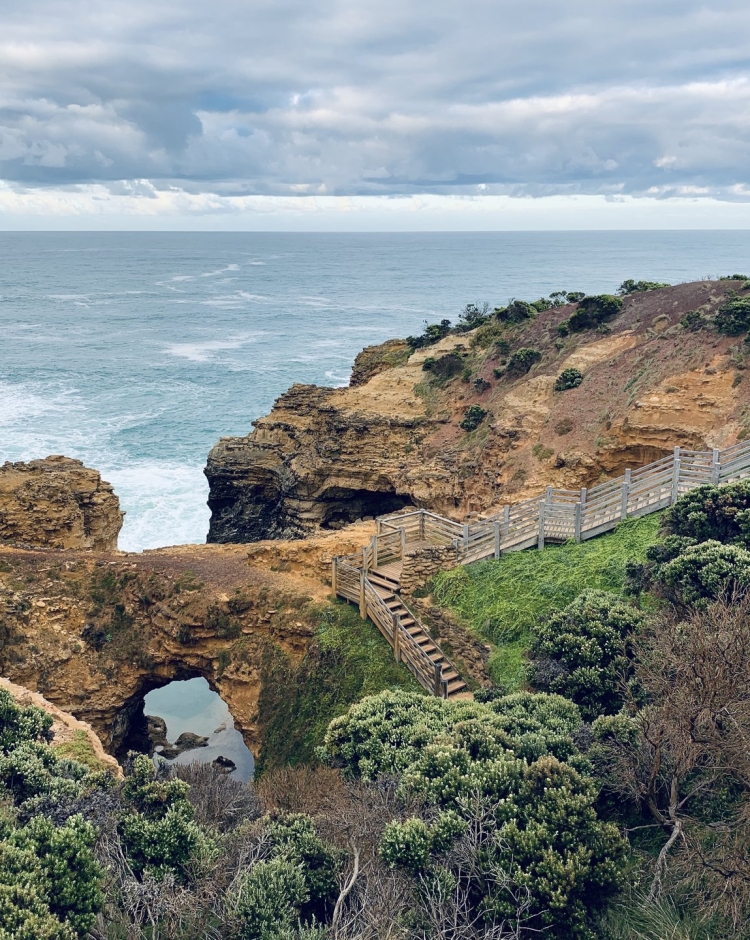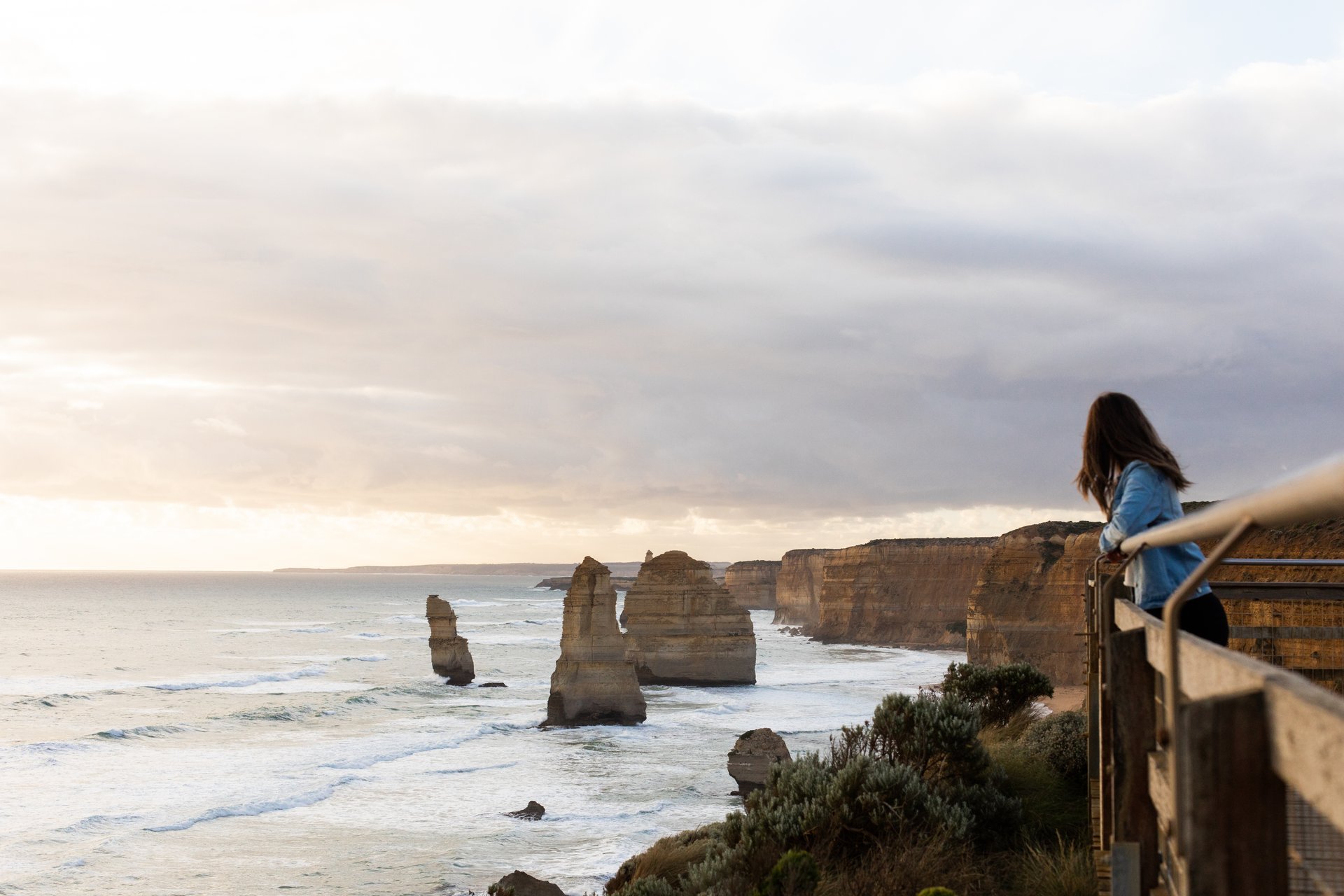

- Explore
- Eat & Drink
- Stay
- Attractions
- Tours
- What’s On
- Deals
- FAQs About The Region
- Plan Your Trip
- Destination Times


The Port Campbell National Park ranges from Princetown to Peterborough. Photographs of these historic sites have long represented the Great Ocean Road. These include the Loch Ard Gorge, London Bridge, The Arch and the Grotto, to name a few.
Take your time exploring these coastal lookouts and trails and learning their amazing historical stories.
An attraction in its own right is the Port Campbell Jetty. You can’t visit Port Campbell without taking the time to stand on this jetty – it is a must do.
A map is available of the whole precinct viewable from the main car park from the nearby Visitor Information Centre in Port Campbell.

The jewel in the crown of the Great Ocean Road and the number one visited attraction in the region is the 12 Apostles. Seeing the beauty of these limestone monuments is unforgettable and absolutely not to be missed. Sunrise and sunset provide even more impressive scenery.
Location: The Twelve Apostles are located on the corner of Booringa Rd and Great Ocean Road in Princetown 3269
Prepare to be dwarfed by the magnitude of the cliff-line and offshore stacks. The sheer scale of natural sculpting evident at this site is humbling.
In local vernacular, Gog and Magog are the names given to the two offshore stacks that may be viewed from both the viewing platform and (tide and sea permitting) from beach level. These are not considered part of the 12 Apostles. The steps were carved into the cliff by local settler Hugh Gibson who worked on traditional access used by the original Kirrae Whurrong inhabitants.
Location: Great Ocean Road, Princetown (5 km west of Princetown township)

Many a visitor holds a special memory of their visit to the Grotto. Spray from waves can cast a fine mist over the low viewing area; sunshine does the rest filling the air with rainbow delights. The still clear water in the open cave casts reflections in contrast to the dynamic moving water of the ocean directly behind it.
The viewing wall is there for visitor protection as the low shelf that feeds the rock pool is regularly crested by waves approaching undetected out of deep water.
Location: The Grotto Track, Peterborough

This site is often spectacular in the afternoon when the formations to the east are bathed in a warm golden light. The walkway descending down to the platform offers an unusual perspective back towards the 12 Apostles. The more famous stacks can be viewed standing boldly against the cliff line they were carved from.
The Arch perches precariously mounted on a harder rock platform proud of the water in small to medium swell. In large swells its formation becomes more evident as waves mount the platform, thick heavy tomes gliding sleekly through the opening and cascading out the other side.
Location: Great Ocean Road, Port Campbell (6.5 km west of Port Campbell)
London Bridge has upper western and lower eastern viewing platforms to take in the sweeping vistas. Visitors were once able to walk (and at one stage drive) across the eastern span that once connected it to the mainland.
London Bridge is one of two points in the National Park where visitors can observe little penguins returning to shore (the other is from the main 12 Apostles viewing platform. The population of 80 — 100 birds at London Bridge is significantly smaller than at the 12 Apostles but the viewing platforms are closer to the birds.
London Bridge, pre-1990 was a double-spanning bridge connected to the mainland. The stack was created over hundreds of years, with the weaker layers toward the base being eroded away by wind and water to form the two bridges.
The span closer to the shoreline collapsed unexpectedly on 15 January 1990, leaving two visitors, whilst uninjured, stranded on the outer span before being rescued by helicopter.
For many people, the publicity surrounding the collapse of London Bridge frames a point in time. Many visitors recount of a loved one that was there a day before or after the event.
The collapse was an incident that highlighted for the first time the distinct lack of permanence of the features that dominate this sculptured coast. And perhaps as a prelude to the stricter visitor management and protective infrastructure that is necessary for safe and ecologically sound experiences.
Location: Great Ocean Road, Port Campbell (7.5 km west of Port Campbell)

It is impossible to walk these trails and not be moved by the powers of nature that have shaped and the shipwreck history that defines the area. Offshore stacks, blowholes and the indescribable beauty of formations like the Razorback and Island arch make this precinct the one with the lot. There is a map of the whole precinct viewable from the main car park and available from the nearby Visitor Information Centre in Port Campbell.
From September to May a colony of short tailed shearwaters (muttonbirds) inhabits the offshore stack that is Muttonbird Island, their nightly return makes a dusk visit all the more worthwhile.
Location: Great Ocean Road, Port Campbell (8 km east of Port Campbell)



Sign up to get the latest deals, tours & events along the Great Ocean Road
Great Ocean Road Regional Tourism acknowledges the Traditional Custodians of the Great Ocean Road region the Wadawurrung, Eastern Maar & Gunditjmara. We pay our respects to their Elders, past, present and emerging. We recognise and respect their unique cultural heritage and the connection to their traditional lands. We commit to building genuine and lasting partnerships that recognise, embrace and support the spirit of reconciliation, working towards self-determination, equity of outcomes and an equal voice for Australia’s first people.